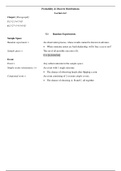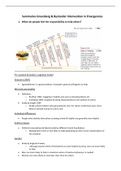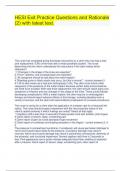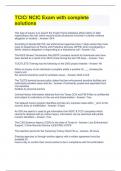Probability & Discrete Distributions
Lecture 6.2
Chapter [Paragraph]:
5 [1-2-3-4-5-8]
6 [1-2*-3-4-5-6-8]
5.1 Random Experiments
Sample Space
Random experiment = An observation process, whose results cannot be known in advance.
When someone enters an Audi dealership, will it buy a car or not?
Sample space = The set of all possible outcomes (S).
𝑆 = {1,2,3,4,5,6}
Event
Event = Any subset outcome in the sample space.
Simple events (elementary-) = An event with 1 single outcome
The chance of observing heads after flipping a coin.
Compound event = An event consisting of 2 or more simple events.
The chance of choosing A, B and C, all together.
, 5.2 Probability
Probability = A number, measuring the relative likelihood that the event will occur.
The probability of an event A, denoted P(A), must lie within the interval
from 0 to 1: 0 ≤ 𝑃(𝐴) ≤ 1
Empirical Approach
Assigns different probabilities by counting the frequency of observed outcomes ( f ) defined in the
experimental sample space and dividing it by the number of observations ( n ).
The estimated probability is f /n.
𝑓𝑟𝑒𝑞𝑢𝑒𝑛𝑐𝑦 𝑜𝑓 𝑜𝑏𝑠𝑒𝑟𝑣𝑒𝑑 𝑜𝑢𝑡𝑐𝑜𝑚𝑒𝑠 ( 𝑓 )
𝑃(𝐴) =
𝑛𝑢𝑚𝑏𝑒𝑟 𝑜𝑓 𝑜𝑏𝑠𝑒𝑟𝑣𝑎𝑡𝑖𝑜𝑛𝑠 ( 𝑛 )
Law of large numbers = Says that as the number of trials increase, any empirical probability approaches
its theoretical limit.
Actuarial science = Estimates empirical probabilities. Actuaries help companies calculate payout
rates on life insurance, pension plans, and health care plans.
Classical Approach
The process of assigning probabilities before actually observing the event or trying an experiment,
(a priori). When flipping a coin, we don’t actually have to perform an experiment since the process’s nature
allows us to envision the entire sample space. The classical approach uses deduction to determine P(A).
𝑓𝑟𝑒𝑞𝑢𝑒𝑛𝑐𝑦 𝑜𝑓 𝑝𝑜𝑠𝑠𝑖𝑏𝑙𝑒 𝑜𝑢𝑡𝑐𝑜𝑚𝑒𝑠
𝑃(𝐴) =
𝑛𝑢𝑚𝑏𝑒𝑟 𝑜𝑓 𝑜𝑢𝑡𝑐𝑜𝑚𝑒𝑠 𝑖𝑛 𝑠𝑎𝑚𝑝𝑙𝑒 𝑠𝑝𝑎𝑐𝑒
Subjective Approach
This approach reflects someone’s informed judgement about the likelihood of an event. It is needed when
there is no repeatable random experiment.
“What is the probability that Ford’s new supplier will meet the deadline?”
“What is the probability the price of water will rise within 30 days?”
, 5.3 Rules of Probability
Complement of an Event
In probability theory, the complement of any event A is the event [A’], i.e., the event that A does not occur.
The event A and its complement [A’] are mutually exclusive and exhaustive.
Union and Intersection of Two Events
The union of two sets is a new set that contains all of the elements that are in at least one of the two
sets. The union is written as 𝐴∪𝐵.
The intersection of two sets is a new set that contains all of the elements that are in both sets. The
intersection is written as 𝐴∩𝐵
Mutually Exclusive Events
Mutually exclusive is a statistical term describing two or more events that cannot happen simultaneously. It
is commonly used to describe a situation where the occurrence of one outcome supersedes the other.
Lecture 6.2
Chapter [Paragraph]:
5 [1-2-3-4-5-8]
6 [1-2*-3-4-5-6-8]
5.1 Random Experiments
Sample Space
Random experiment = An observation process, whose results cannot be known in advance.
When someone enters an Audi dealership, will it buy a car or not?
Sample space = The set of all possible outcomes (S).
𝑆 = {1,2,3,4,5,6}
Event
Event = Any subset outcome in the sample space.
Simple events (elementary-) = An event with 1 single outcome
The chance of observing heads after flipping a coin.
Compound event = An event consisting of 2 or more simple events.
The chance of choosing A, B and C, all together.
, 5.2 Probability
Probability = A number, measuring the relative likelihood that the event will occur.
The probability of an event A, denoted P(A), must lie within the interval
from 0 to 1: 0 ≤ 𝑃(𝐴) ≤ 1
Empirical Approach
Assigns different probabilities by counting the frequency of observed outcomes ( f ) defined in the
experimental sample space and dividing it by the number of observations ( n ).
The estimated probability is f /n.
𝑓𝑟𝑒𝑞𝑢𝑒𝑛𝑐𝑦 𝑜𝑓 𝑜𝑏𝑠𝑒𝑟𝑣𝑒𝑑 𝑜𝑢𝑡𝑐𝑜𝑚𝑒𝑠 ( 𝑓 )
𝑃(𝐴) =
𝑛𝑢𝑚𝑏𝑒𝑟 𝑜𝑓 𝑜𝑏𝑠𝑒𝑟𝑣𝑎𝑡𝑖𝑜𝑛𝑠 ( 𝑛 )
Law of large numbers = Says that as the number of trials increase, any empirical probability approaches
its theoretical limit.
Actuarial science = Estimates empirical probabilities. Actuaries help companies calculate payout
rates on life insurance, pension plans, and health care plans.
Classical Approach
The process of assigning probabilities before actually observing the event or trying an experiment,
(a priori). When flipping a coin, we don’t actually have to perform an experiment since the process’s nature
allows us to envision the entire sample space. The classical approach uses deduction to determine P(A).
𝑓𝑟𝑒𝑞𝑢𝑒𝑛𝑐𝑦 𝑜𝑓 𝑝𝑜𝑠𝑠𝑖𝑏𝑙𝑒 𝑜𝑢𝑡𝑐𝑜𝑚𝑒𝑠
𝑃(𝐴) =
𝑛𝑢𝑚𝑏𝑒𝑟 𝑜𝑓 𝑜𝑢𝑡𝑐𝑜𝑚𝑒𝑠 𝑖𝑛 𝑠𝑎𝑚𝑝𝑙𝑒 𝑠𝑝𝑎𝑐𝑒
Subjective Approach
This approach reflects someone’s informed judgement about the likelihood of an event. It is needed when
there is no repeatable random experiment.
“What is the probability that Ford’s new supplier will meet the deadline?”
“What is the probability the price of water will rise within 30 days?”
, 5.3 Rules of Probability
Complement of an Event
In probability theory, the complement of any event A is the event [A’], i.e., the event that A does not occur.
The event A and its complement [A’] are mutually exclusive and exhaustive.
Union and Intersection of Two Events
The union of two sets is a new set that contains all of the elements that are in at least one of the two
sets. The union is written as 𝐴∪𝐵.
The intersection of two sets is a new set that contains all of the elements that are in both sets. The
intersection is written as 𝐴∩𝐵
Mutually Exclusive Events
Mutually exclusive is a statistical term describing two or more events that cannot happen simultaneously. It
is commonly used to describe a situation where the occurrence of one outcome supersedes the other.












